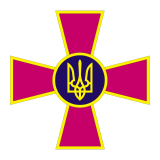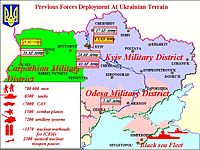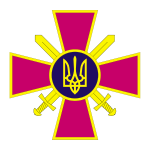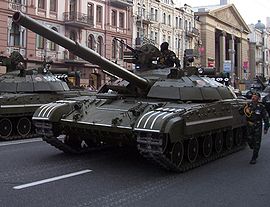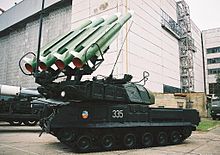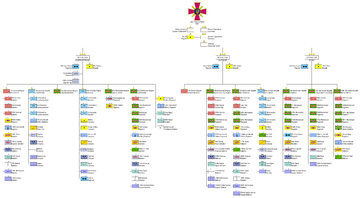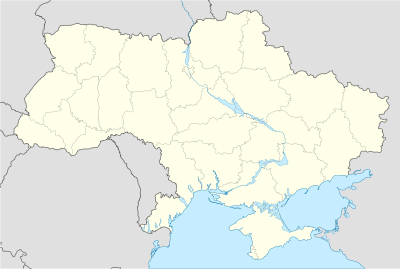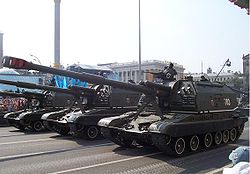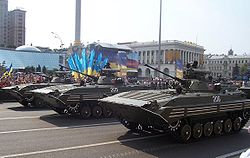- Ukrainian Ground Forces
-
"Ukrainian Army" redirects here. For historical armies of Ukraine, see Ukrainian Army (disambiguation)
Military of Ukraine Main branches  Ukrainian Air Force
Ukrainian Air Force Ukrainian Ground Forces
Ukrainian Ground Forces Ukrainian Navy
Ukrainian NavyOther Corps  Ukrainian Marine Corps
Ukrainian Marine Corps Ukrainian Mechanized Forces
Ukrainian Mechanized Forces Ukrainian Airmobile Forces
Ukrainian Airmobile ForcesRelated Services  Ministry of Defense
Ministry of Defense General Staff
General Staff Ministry of Internal Affairs
Ministry of Internal Affairs National Space Agency
National Space AgencyIntelligence  Security Service of Ukraine
Security Service of Ukraine Foreign Intelligence Service
Foreign Intelligence Service Military Intelligence Service
Military Intelligence ServiceHistory of the Ukrainian Military History of Ukraine History of Ukraine during WWII History of Ukraine during WWI The Ukrainian Ground Forces (Ukrainian: Cухопутні Війська ЗСУ, Sukhoputni Viys’ka ZSU) are the land force component of the Military of Ukraine. They were formed from Soviet Army formations, units, and establishments, including three military districts (the Kiev, Carpathian, and Odessa Military Districts), that were on Ukrainian soil when the Soviet Union collapsed in 1990-92. Between the fall of the USSR and the late 1990s, Ukraine kept much army equipment from that era. Since then, however, Ukraine has upgraded its Ground Forces with advanced additions from domestic engineering and modifications. Currently, the Ukrainian Armed forces buy military equipment only from Russia and other CIS states, as well as locally producing some of their own equipment.
Contents
History
Early history
Before the collapse of the Soviet Union, three separate self-governing Ukrainian states were in existence during the 20th Century, all of which had national armed forces. The largest of these, the Ukrainian People's Republic, itself existed of three separate regimes. The Ukrainian People's Army is an example of one of the early national armed forces. Other armed independence movements existed in the wake of both the First World War and the Second World War, and these militaries had their own organization and uniforms. These armed forces, and the independent Ukrainian homeland for which they fought, were eventually incorporated into the neighbouring states of Poland, Soviet Union, Hungary, Romania and Czechoslovakia.[1]
Collapse of the USSR
Following the dissolution of the Soviet Union and renewed declaration of Ukrainian independence in 1991, Ukraine inherited one of the largest and most powerful armies in Europe. The Ukrainian military was equipped with modern tanks, APCs, artillery, missile defense technology and nuclear weapons. At that time, the ground forces of Ukraine included: three armies of combined forces (including the 1st Guards Army, 13th Army and 38th Army), two tank armies (the 6th Guards Tank Army and the 8th Tank Army), and the 32nd Army Corps at Simferopol.
The Armed Forces of Ukraine included approximately 780,000 personnel, 7000 armored vehicles, 6,500 tanks, and 2,500 tactical nuclear missiles when they were established. However, the problem that Ukraine face was that while it had a vast military, it lacked a proper, centralized command structure. Therefore, on 24 August 1991, the Verkhovna Rada of Ukraine ratified the resolution of taking under its control, all military units of former Soviet Armed Forces, situated on the territory of Ukraine; and in turn the establishment of one of the most important Ministries, the Ministry of Defense. By the end of 1992, the Kiev Military District disbanded, and Ukraine used its structures as the basis for the Ukrainian Ministry of Defence and General Staff.[2]
Reform and development
The Ground Forces are implementing a plan, made in 2000, that includes a reduction in the number of troops from its current 300,000 to 240,000 by 2015, and an ultimate change from a partial conscript-based force to a fully professional military.[3] Even though the Ukrainian military received little more than half of the Hr 68 million it was promised for reform in 2001, officials were able to disband nine regiments and close 21 local military bases.
According to the State Program of the Ukrainian Armed Forces reform and development to 2005, the ground forces will have the biggest ratio of personnel of all services (up to 54%). This ratio is based on the missions assigned to the armed forces, and also on the fact that current economical situation in Ukraine cannot support any larger troop numbers. However, the ground forces still have priority in the number of personnel, weapons, military equipment development priorities and the development of their future systems, which will correspond to modern warfare requirements. The ground forces will closely coordinate their assignments with other army branches, engaging appropriate military arts and equipment. They will also be involved in law enforcement activities during emergencies, dealing with consequences of technological and natural disasters, providing military assistance to other countries, engaging in international military cooperation activities (UN), and participating in international peacekeeping operations according to international agreements.
In the short term, the conversion to a professional army will not save Ukraine any money because training and housing greater numbers of professional soldiers will cost more than supporting recruits. However, in the long term, a reduced number of soldiers serving longer terms will not only help conserve the military budget, but will also allow for better training of its forces.
Training
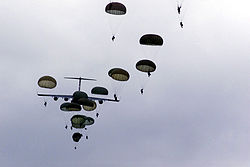 Ukrainian paratroopers during a joint exercise with the 82nd Airborne Division (United States).
Ukrainian paratroopers during a joint exercise with the 82nd Airborne Division (United States).
Ukrainian armed forces training in 2006 was aimed at supporting the mobility and the readiness of forces to perform the specified missions in the defined situations of employment. It took into consideration the current force strength, organization and staff structure, level of manning, weapons and equipment, and reserves of material and technical means.[4]
The level of the Ukrainian armed forces combat readiness is an indicator of the efficiency of military command and control, and a measure of expediency of implementing the defense budget. It is also the main factor of improvement of Ukraine’s image in the sphere of international stability and security. Thus, the Ministry of Defense and the General Staff concentrated their main efforts on setting the goals and content of personnel combat training for taking practical measures for its intensification and reaching the final results according to the strategic concept of employing the Ukrainian armed forces.[4]
Main efforts and resources were directed to Joint Rapid Reaction Forces (JRRF) training. Measures were also taken to maintain the high level of combat efficiency of the Main Defense Forces units, performing of missions by the units, securing and practicing joint actions with other formations. The Ukrainian armed forces took advantage of the opportunities provided by multinational exercises to raise the level of their combat efficiency.[4]
2006 also saw the first ever large-scale Ukrainian tactical special exercise with practical deployment of a military mobile hospital of the Military Medical Center of the air force. It involved several ambulance aircraft and armored equipment (APC). During the practical phase the possibilities of use of the medical evacuation aircraft. Medical evacuation helicopters and automobiles were also tested. The training framework included an international research conference on the “Methodological basis of medical support organization of the Armed Forces”, in which representatives of the armed forces of Ukraine, NATO nations and other partners participated.[5]
In 2007 the system of exercise/training ranges was optimized, decreasing their number and providing a specialized role.[6]
Training Ranges of the Ground Forces:
- Zhitomir Combined Arms Training Range
- Yavoriv Combined Arms Training Range
- Yavoriv International Centre for Peacekeeping and Security
- Shyroky Lan Range
- Desna Ground Forces Training centre
Branches of the Ground Forces
Armored and mechanized forces
Main articles: Mechanized Infantry (Ukraine) and Armored Force (Ukraine)Mechanized and armored forces are the main components of the Ukrainian Ground Forces. Their primary objectives in war are to hold occupied areas, lines, and positions, defend against attack, penetrate an enemy’s defense lines, defeat the enemy forces, capture important areas, lines, and objectives, and finally supply support for marines and other landing troops.
The formations of the mechanized and armored forces are mainly equipped with main battle tanks, though almost all of Ukrainian T-72s have been retired in favor of upgraded T-80s and new T-84 tanks. T-64, T-72, T-80, T-84, wheeled armoured personnel carriers BTR-60, BTR-70, BTR-80, and tracked infantry fighting vehicles BMP-1, BMP-2, and BMD-2 (used by airmobile forces).
Since the fall of the Soviet Union, a large number of the previous Soviet mechanized formations on Ukrainian soil have been disbanded – the IISS says totals have dropped from 14 divisions, in 1992, to two divisions, six brigades, and one independent regiment in 2008.[7] Today, all mechanized and armored formations are called brigades. However, some former divisions remain near division strength.
Airmobile Forces and Army Aviation
Main article: Ukrainian Airmobile ForcesThe Army aviation, having to cover troop movements, is by far the most maneuverable branch of the army, intended to conduct the operations under all sorts conditions of combat arms procedures. Among the priorities of the Ukrainian army aviation's units is to provide reconnaissance, attack enemy weapon systems, provide equipment and human resources, give tactical fire support during an offensive or counterattack, land airmobile troops, and to deliver combat weapons and personnel at the specified areas and execute other main tasks. The Army aviation's structure consists of two regiments. The army aviation troops are equipped with Mi-8, Mi-24 helicopters, and their variants.
Seeing as the Ukrainian military doctrine is strictly defensive the airmobile forces serve as the quick response units of the army, in the event of an attack on Ukraine's sovereignty. Airmobile forces' structure consists of formations and elements of the army and the army aviation. These units are well trained for offensive activities behind enemy lines. The airmobile forces are in constant combat readiness and base their battle plan is high mobility, which allows them to conduct any combat task under any conditions. The airmobile forces consist of two airmobile brigades, an airborne brigade, and one airmobile regiment.[8] Some of the airmobile formations previously grouped into the 1st Airmobile Division but this has now been disbanded.
Rocket and Artillery troops
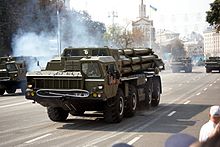 Ukrainian BM-30 Smerch heavy multiple rocket launchers on parade in Kiev
Ukrainian BM-30 Smerch heavy multiple rocket launchers on parade in Kiev Main article: Rocket Forces and Artillery (Ukraine)
Main article: Rocket Forces and Artillery (Ukraine)Rocket Forces and Artillery troops of the army consist of formations of operational-tactical and tactical missiles, self-propelled artillery, howitzers, jet-propelled and anti-tank artillery, artillery reconnaissance units, of mortar units and of units of anti-tank missiles. These forces operate as support for they other army formations, therefore, they are obliged to destroy enemy human resources, tanks, artillery, anti-tanks weapons, aircraft, objects of air defense and other important objects during the combat arms operations. Rocket and artillery troops are equipped with: missile complexes of operational-tactical and tactical missiles; Multiple rocket launcher rocket systems, such as the Smerch, Uragan, Grad; also, Giatsint, Pion, Akatsiya, Gvozdika howitzers; and, Konkurs, T-12 antitank gun anti-tank weapons.
Army Air Defense
The Army Air Defense units are responsible for covering troops against enemy air attacks anywhere on the battlefield, and while in combat. The Ukrainian Ground Forces army air defense branch is equipped with a variety of effective surface-to-air missile systems of division level and anti-aircraft missile and artillery complexes of regiment level. Regiment level units are characterized by their high rate of fire, vitality, maneuverability, and capability of action under all conditions of modern combat arms operations. Surface-to-air missile systems and complexes of division level are characterized by their long range and firepower and are equipped with surface-to-air missile complexes;S-300V,Osa, Buk, Buk-M1 and Tor. While anti-aircraft missile and artillery complexes that are of regiment level are equipped with the Tunguska-M1, Igla MANPADS system, Strela, and Shilka anti-aircraft missile systems.[9] While the army's only separate radar system, meaning it isn't a part of any anti-aircraft system, is the Ukrainian Kolchuga-M. It was designed sometime between the years 1993-1997, the system is said to be one the most (if not the most) advanced passive sensors in the world, as it was claimed to be able to detect stealth aircraft.[10]
Current Structure
Structure of Ukrainian Ground Forces at the end of 2009 was:[11]
- Operational Commands – 2;
- Territorial Directorate – 1;
- Army Corps – 3;
- Brigades – 17 (Mechanized – 8, Armored – 2, Airmobile – 2, Airborne – 1, Artillery – 3, Rocket – 1);
- Regiments – 23 (Mechanized – 1, Airmobile – 1, Reactive Artillery – 3, Air Defence – 3, Special Purpose – 2, Army Aviation – 2, Signal – 4, Engineer – 4, Electronic warfare – 1, Radiological, Chemical, and Biological Defence – 1, Special – 1);
- Training Centers – 1
Detailed Structure
- Ground Force Command
 6th Army Corps (Dnipropetrovsk)
6th Army Corps (Dnipropetrovsk)
 25th Airborne Brigade (Cherkaske)
25th Airborne Brigade (Cherkaske) 79th Airmobile Brigade
79th Airmobile Brigade 28th Guards Mechanized Brigade (Chornomorske)
28th Guards Mechanized Brigade (Chornomorske) 92nd Guards Mechanized Brigade (Chuhuiv)
92nd Guards Mechanized Brigade (Chuhuiv) 93rd Guards Mechanized Brigade (Cherkaske)
93rd Guards Mechanized Brigade (Cherkaske)- 17th Guards Armored Brigade (Kryvyi Rih)
- 55th Artillery Brigade
- Corps Units
 8th Army Corps (Zhytomyr)
8th Army Corps (Zhytomyr)
 1st Armored Brigade (Honcharivske)
1st Armored Brigade (Honcharivske) 30th Mechanized Brigade (Novohrad-Volynskyi)
30th Mechanized Brigade (Novohrad-Volynskyi) 72nd Mechanized Brigade (Bila Tserkva)
72nd Mechanized Brigade (Bila Tserkva) 95th Airmobile Brigade (Zhytomyr)
95th Airmobile Brigade (Zhytomyr) 26th Artillery Brigade (Berdychiv)
26th Artillery Brigade (Berdychiv) 3rd Army Aviation Regiment (Brody)
3rd Army Aviation Regiment (Brody)- Corps Units
 13th Army Corps (Rivne) (former Soviet 13th Army)
13th Army Corps (Rivne) (former Soviet 13th Army)
 Western Operational Command (former Soviet Carpathian Military District)
Western Operational Command (former Soviet Carpathian Military District) Southern Operational Command (former Soviet Odessa Military District)
Southern Operational Command (former Soviet Odessa Military District) Territorial Directorate "North"
Territorial Directorate "North" Military University (Lviv)
Military University (Lviv) 19th Rocket Brigade
19th Rocket Brigade- other various Ground Force Command Support Units
Strength and Military Equipment
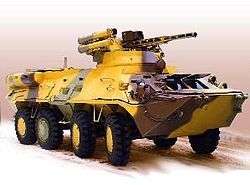 Ukrainian BTR-3U in desert camouflage
Ukrainian BTR-3U in desert camouflage
- 73,300 Personnel[12]
- 735 Tanks[12]
- 2,155 Armoured Combat Vehicles[12]
- 72 Combat Helicopters[12]
- 892 Artillery Systems[12]
Tanks
- T-84 Oplot
- T-80UD (Ukrainian diesel version)
- T-72 - 1,302 (not used, in reserve)
- T-64 - 2,281 (786 T-64B, T-64BV, T-64BM "Bulat" in service)
- T-64BM "Bulat" (Ukrainian version)- 56[13]
APC's and IFV's
- BMP-1 (some upgraded with Shkval turret) - 1,008[14]
- BMP-2 - 1,434 [14]
- BMP-3 - 4 (not used, in reserve)
- BTR-60 - 176 [14]
- BTR-70 (some upgraded with diesel engine) - 1,026[14]
- BTR-80 - 456[14]
- BTR-94 Modified version of BTR-80 with ZU-23-2 23mm gun and coaxial PKT machinegun. (Ukrainian version)
- BTR-3 (Ukrainian designed, not used by Ukrainian military)
- BTR-4 New Ukrainian 8x8 BTR family.
- MT-LB - 2,315
- HMMWV 12 vehicles donated by the United States to UKRPOLBAT.[15][16][17][18]
- Dozor-B (Ukrainian designed, not used by Ukrainian military)
Combat Helicopters
Artillery
- BM-21 "Grad" MRL 122 mm - 450 [19]
- 9P140 "Uragan" MRL 220 mm - 76 [19]
- 9A52-2 "Smerch" MRL 300mm - 100 [19]
- 2S1 "Gvozdika" SP howitzer 122mm 638 [14]
- 2S3 "Akatsiya" SP howitzer 152mm 501
- 2S5 "Giatsint-S" SP gun 152mm 24 [14]
- 2S19 "Msta-S" SP howitzer 152mm 40 [14][19]
- D-20 152mm howitzer
- D-30 howitzer 122mm 443
Armies of Ukraine  Kievan Rus'
Kievan Rus'
- Druzhyna (862–1240)
- Voyi
 Kingdom of Galicia–Volhynia
Kingdom of Galicia–Volhynia
- Druzhyna (1199–1392)
- Voyi
 Cossack Hetmanate
Cossack Hetmanate
- Zaporozhian Host (1492–1775)
- Registered Cossacks
 Ukrainian National Republic
Ukrainian National Republic
- Ukrainian People's Army (1917–21)
- Ukrainian Galician Army (1918–19)
 Ukrainian National state
Ukrainian National state
- UPRA (1941–1944)
- Ukrainian Insurgent Army (1941–1955)
 Ukrainian SSR
Ukrainian SSR
- Soviet Armed Forces (1918–1991)
 Ukraine
Ukraine
- Armed Forces (1992–Present)
Anti-Aircraft[20]
- Army level
- S-300V1, (SA-12 Gladiator) [21]
- Kolchuga passive sensor (Ukrainian-designed)
- Division (brigade) level
- Tor Missile System or 9K330 Tor, (SA-15 Gauntlet)
- 9K37 Buk (SA-11 Gadfly)
- 9K37M1-2 Buk-M1-2 (SA-17 Grizzly)
- Regiment level
- 9K35 Strela-10 (SA-13 Gopher)
- Tunguska M1 LLAD (SA-19 Grison)
- ZSU-23-4 "Shilka - 300
- 9K38 Igla (SA-18 Grouse)
Surface to Surface tactical missiles
- OTR-21 Tochka (SS-21 Scarab) - 90 [14]
Small arms
- Vepr (Ukrainian-designed) [22]
- TAR-21 (Built Under License) [23]
- AK-74
- AKM
- Makarov PM
- Fort 12 (Ukrainian designed) [24]
- RPK-74
- RPK
- PKM
- Dragunov SVD
- 9M113 Konkurs (AT-5 Spandrel)
- 9M111 Fagot (AT-4 Spigot)
- 9K115-2 Metis-M (AT-13 Saxhorn-2)
- 9M133 Kornet (AT-14 Spriggan)
- RPG-29
- RPG-22
- RPG-7
See also
References
- ^ Abbott, P. & E. Pinak Ukrainian Armies (Osprey Publishing Ltd., 2004)
- ^ ANALYSIS: Ukraine adopts program for military reform, 03/02/1997
- ^ http://merln.ndu.edu/whitepapers/Ukraine_Eng-2005.pdf , page 4 of 136
- ^ a b c Ukrainian Armed Forces 2006 White Book p.25
- ^ Ukrainian Armed Forces 2006 White Book p.26
- ^ Ukrainian Armed Forces 2007 White Book p.42
- ^ IISS Military Balance 1992/3, p 86, and Military Balance 2008, p 188
- ^ Военно-промышленный комплекс | Електронні вісті
- ^ Structure of Ukrainian Armed Forces
- ^ http://thereliant.blogspot.com/2006/09/in-focus-kolchuga-esm-system.html
- ^ (in Ukrainian) Ukrainian Armed Forces 2009. February 23, 2010. p. 17. http://www.mil.gov.ua/files/white_book/WB2009_ukr.pdf. Retrieved February 25, 2010.
- ^ a b c d e Ukrainian Armed Forces 2009 White Book p.79
- ^ (Ukrainian) 29 T-64s to be upgraded to Bulats for 1st Armored Brigade
- ^ a b c d e f g h i Ground Forces Equipment - Ukraine
- ^ Новини Управління Прес-служби МО
- ^ Новини Управління Прес-служби МО
- ^ Новини Управління Прес-служби МО
- ^ Новини Управління Прес-служби МО
- ^ a b c d http://www.mil.gov.ua
- ^ Note: This list does not include other anti-aircraft systems employed by the air defense forces
- ^ Armament of Ukrainian Armed Forces
- ^ http://world.guns.ru
- ^ [1]
- ^ http://world.guns.ru
- General Sources
- Globalsecurity's 2002 report
- IISS Military Balance 2006
- The Ukrainian Army - uarmy.iatp.org.ua
- Analysis of the Ukrainian Security Policy
- Other images from foxbat.ru
- Ukraine as a Post-Cold War Military Power
- Ukraine's strategic Defence bulletin
- Ukrainian Army Aviation
External links
- The Army of the Armed Forces of Ukraine at the Ministry of Defence of Ukraine
- Armament of Ukrainian Ground Forces at the Ministry of Defence of Ukraine
- Ukraine: Ground Forces Equipment
- Vepr Assault Rifle
Military of Ukraine Other Services:
 Marine Corps ·
Marine Corps ·  Airmobile Forces ·
Airmobile Forces ·  Mechanized Infantry ·
Mechanized Infantry ·  Armored Force
Armored Force
 Naval Aviation ·
Naval Aviation ·  Guards Units ·
Guards Units ·  Military Police
Military Police
 Border Guards ·
Border Guards ·  Sea Guard
Sea GuardMilitary Formations · Defence companies of Ukraine Armies (land forces) in Europe Sovereign
states- Albania
- Andorra
- Armenia
- Austria
- Azerbaijan
- Belarus
- Belgium
- Bosnia and Herzegovina
- Bulgaria
- Croatia
- Cyprus
- Czech Republic
- Denmark
- Estonia
- Finland
- France
- Georgia
- Germany
- Greece
- Hungary
- Iceland
- Ireland
- Italy
- Kazakhstan
- Latvia
- Liechtenstein
- Lithuania
- Luxembourg
- Macedonia
- Malta
- Moldova
- Monaco
- Montenegro
- Netherlands
- Norway
- Poland
- Portugal
- Romania
- Russia
- San Marino
- Serbia
- Slovakia
- Slovenia
- Spain
- Sweden
- Switzerland
- Turkey
- Ukraine
- United Kingdom
- Vatican City
States with limited
recognition- Abkhazia
- Kosovo
- Nagorno-Karabakh Republic
- Northern Cyprus
- South Ossetia
- Transnistria
Categories:- Military of Ukraine
- Armies by country
Wikimedia Foundation. 2010.

